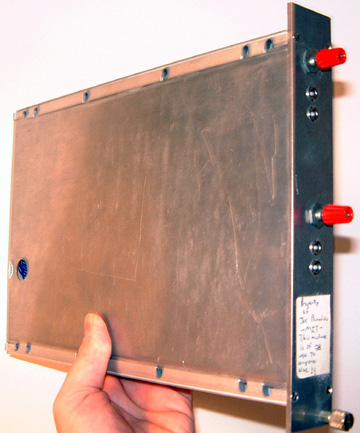
I spent the winter of 1979-1980 in Europe as a graduate student of the MIT physics department, working at our R209 muon pair experiment running at the Intersecting Storage Rings at the CERN Laboratory in Geneva, Switzerland. These were extremely stimulating years; CERN is a fantastic environment for high-energy physics (especially then, as it was about to enter a golden age with the launch of the p-bar-p collider), and living in Geneva was fabulous; with the French Alps and Jura nearby, there were many highpoints. Things quieted down though as the winter shutdown began at CERN and all of the postdocs left town for the holidays. I myself was about to leave for a couple of weeks in Rome to visit relatives, but there was a good gap of a week or two beforehand when I had a fair amount of time on my hands and a nice workshop available (always a dangerous situation). Although I often took advantage of an old piano that was hidden in a cable tunnel under the main CERN restaurant, I missed my synthesizers, and wanted to play with electronic music again. As my group had a nice PDP-11 running in our counthouse that drove several data acquisition crates operating under the CAMAC standard, I decided to design and build a small computer-controlled analog synthesizer into a CAMAC module. The device was conceptually very simple, as depicted in the block diagram. It contained two digitally-programmable pulse-wave oscillators, each with continuous pulse-width and amplitude control. You could also select a subharmonic for each oscillator and control its amplitude. I built it with standard CMOS components onhand in our stock - as there were no DAC's, PLD's, etc. available, I built everything out of drivers, flip-flops, latches, data selectors, op-amps, etc., hence the inside of the module was quite dense. The front panel was very sparse, featuring only volume controls and line and speaker audio outputs. It was nicely hidden in the mess of cables that formed our count house - nobody knew it was there except me for a while - it was indeed a standard CAMAC module. Once it was working, I started by having it chime the hour in our counthouse, then wrote several FORTRAN music-generating programs for it on our PDP-11 and a few BASIC programs on a CERN Caviar workstation. Eventually it got somewhat popular, and people would come by from all over CERN to give it a listen. As I used poorly compensated analog exponentiators between the linear DAC output and the linear oscillators to maintain smooth control across several octaves (OK, today it could easily be run on a single 8-bit microprocessor, but it was a little harder back then, so I used analog multivibrators), it could drift with temperature. Fortunately, the counthouse was usually precisely air conditioned, hence the voicings stayed fairly stable (my thesis advisor nicknamed it "Old Crow", in that he first heard it chime the hour when the air conditioning was off). Unfortunately, although I still have the now quite obsolete module in my office (after all, it is probably the world's only CAMAC music synthesizer), it seems that I've lost the few recordings that I'd made. I did run across one piece, however, where I used sounds generated by it. It's an introduction to a late-night radio show I used to do occasionally at MIT's FM station, WMBR, called the Asylum. I put it together when I returned from CERN and was writing my Ph.D. thesis (winter 1980/81) - it's composed of the CAMAC synth driven by a FORTRAN program making random sound events (a live recording with a bit of tape echo added) interposed with excerpts of me doing meaningless state-of-consciousness rap and bits of odd dialog from tape scraps that I had found in the station's "discard" bin. All was of course cut with razors and spliced by hand, as we had to do in the age of analog audio. Granted, it gets a bit tiring, but for the sake of posterity, this piece is posted here as an MP3 file (2.8 Meg).
